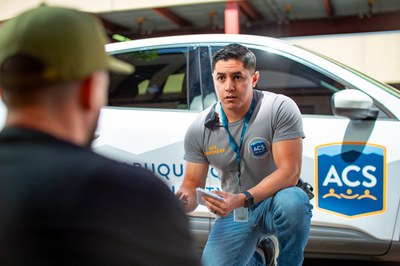What Does an ACS Response Look Like?
What kinds of concerns are eligible for an ACS response?
- Behavioral health crises,such as a loved one with a mental health disorder who has become upset and is making threats.
- Disturbances, such as someone yelling outside a business or people arguing in a public space.
- Panhandlers, when they are in need of support or are in an unsafe location.
- Suicidal ideation, when you or a loved one are thinking of committing suicide and may even have a plan and the means to do so.
- Unsheltered individuals, who need support and connection to services.
- Welfare checks, such as an elderly parent you haven’t been able to get ahold of.
- Wellness checks, such as a person lying in a median whose safety you’re concerned for.
- Other crises that do not involve a crime or a medical emergency
What does an ACS Responder do?
Every ACS response is unique to its circumstances, and ACS has multiple responder types based on the nature of the call. Throughout a response, an ACS responder will:
- De-escalate any immediate crisis whether it be a mental health issue or a conflict between people
- Assess what underlying needs are causing the current issue
- Address those needs that can be solved in the moment
- Connect neighbors to appropriate community-based care through a referral or by directly transporting them to a shelter or provider
- Collaborate with other City departments that could support the situation
What if somebody declines services?
ACS responders are not responsible for enforcing the law and will not detain or otherwise compel an individual to take specific actions. Our teams are persistent and creative, but will never transport or engage with an individual who does not consent. Instead, they will attempt to build rapport with each person and identify immediate needs and challenges to support them in reducing harm to themselves and others.
What happens with common ACS calls?
ACS often encounters similar situations. Below are common outcomes of some of our most frequent call types. Multiple outcomes usually occur during the same response.
Unsheltered Individuals
- Unable to locate individual: Particularly when a concerned bystander calls on behalf of an unsheltered neighbor, that person has often moved on to another location and ACS was unable to find them.
- Individual refused services: ACS attempted to engage with the person, but they did not consent to the interaction. As long as they were not a threat to themselves or others, responders left the area.
- Ensured safety: If the person was in a narrow median or other unsafe location, encouraged them to move to a safer location. APD may have been requested if the person was uncooperative and their safety or the safety of others was at risk.
- Person was not unsheltered: Sometimes bystanders mistake someone as being unsheltered and they do not need any services.
- Directly met a need:
- Performed a behavioral health crisis intervention
- Provided food, water, or clothing
- Performed first aid
- Educated on available resources: Assessed the person’s background and circumstances. Informed them of the resources and providers that would best meet their needs.
- Connected to a resource: Made a warm handoff phone referral to a service provider and ensured the person had and agreed to a plan for getting themselves to that service.
- Transported: Directly transported to a shelter or other community-based service provider.
Performed a lifesaving technique: Administered Narcan if the person had overdosed or performed CPR in case of cardiac arrest. - Requested EMS: Unsheltered individuals often have untreated wounds or illnesses. Called out EMS to address a medical issue.
Encampments
ACS responders approach encampments with the needs of the individual top of mind. The same needs assessment and attempt to connect to services would lead to the outcomes listed above. However, the presence of an encampment may lead to the following additional outcomes:
- Offered transport to a shelter and assistance with their belongings
- Informed that other City departments may come and enforce city ordinance
- Referred to the Solid Waste Department for outreach and clean-up
- Referred to Planning for code enforcement
- Referred to transit for clean-up (if at Transit facility)
- Referred to Animal Welfare for concerns regarding animals
- Referred to APD for law enforcement
- If the encampment is abandoned, referred to Parks and Recreation for clean-up (if located within a City Park)

